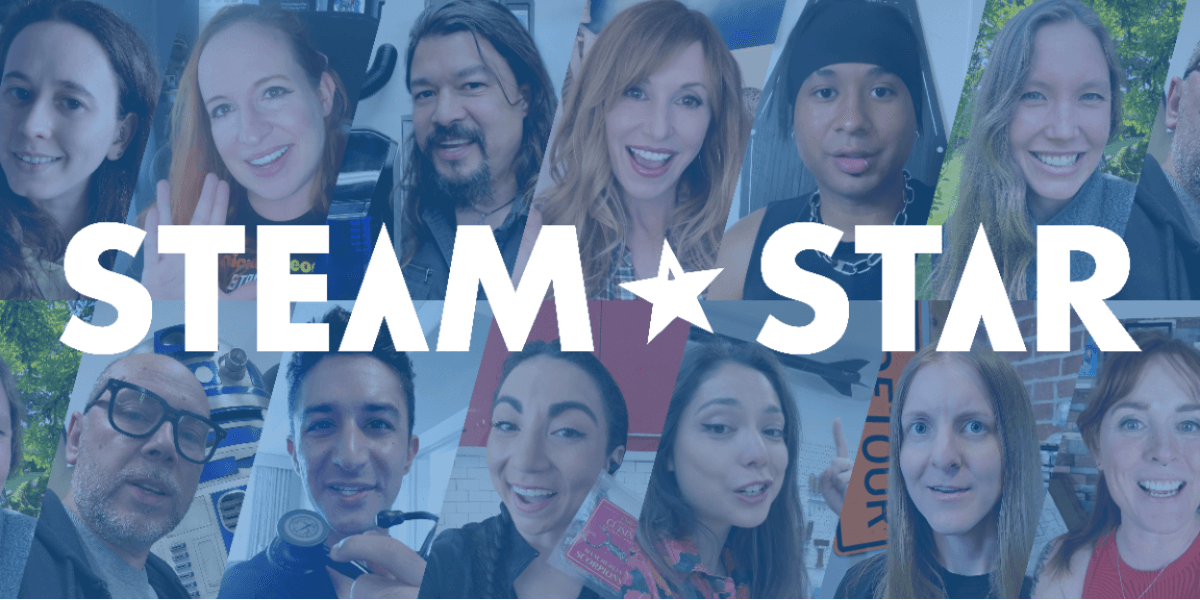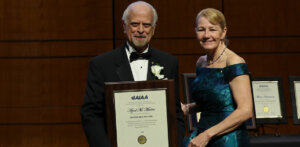
Kenneth “Super Ken” Calhoun turns people into werewolves. Sometimes demons.
But when he was just starting out, Calhoun, a special effects makeup artist on such films and TV shows as “The Mandalorian,” “Jurassic World” and “Avengers: Age of Ultron,” discovered that most effects makeup was only for light skinned people.
In short, it was not for him.
So Calhoun started mixing his own colors. “At the source of everything we do are two things,” he said. “We are chemists, and we are painters.”
By utilizing the reactions and bonding between the smallest polymers and the subtle detailing of paint, Calhoun began to create unique special effects makeup and prosthetics for some of our most beloved fantasy and sci-fi movies and characters.
This is the pedagogy and working philosophy of the wildly creative and talented STEAM Stars at the Grant Imahara STEAM Foundation: How the small and the innocuous can create something entirely new and marvelous.
And now, in a new partnership between the USC Viterbi School of Engineering and the Grant Imahara STEAM Foundation, the USC Viterbi K-12 STEM Center is bringing video stories like Calhoun’s to a new generation of young people.
In the face of immense technological advancement, STEM educators explore how to best introduce the nebulous world of technology and science to younger generations. As technological developments become more entrenched in our lives, what kind of innovative methods of teaching and curriculum can be used to inspire aspiring youth? What is the best way to teach young scholars and students about the many applications, uses, and presence of STEM in their professional and personal lives?
The USC Viterbi School of Engineering’s K-12 STEM Center and the Grant Imahara STEAM Foundation may have just found a surprising answer to challenge traditional STEM pedagogy: through a love of the small things.
Finding Wonder in The Small Things: Algae-Based Molds
Much like Calhoun’s creations of wonder and fantasy, many everyday materials can be combined to create something exciting and new. The small things that we see all around us have the potential to become something extremely new and important.
It was this innovative application of engineering and scientific principles that Alexandra Gutierrez, previously an academic coordinator at USC Viterbi’s K-12 STEM Center, sought to bring to the classroom.
Collaborating with STEAM Star and Special FX Artist Kenneth Calhoun and the Grant Imahara STEAM Foundation, Alexandra created a curriculum through which students learned about the world of special effects and its STEM fundamentals. Students were provided with the opportunity to create algae-based molds similar to those used in special effects to create prosthetics used in films and tv shows. The activity allowed students to exercise creative freedom and ingenuity to build molds on various objects of their choice while learning the basics of sustainability, engineering and science.
“The curriculum hit a lot of educational points,” said Alexandra, who is also a MESA (Math, Engineering, Science, and Achievement) teacher at Environmental Charter Schools. “Math teachers can use it; science teachers can use it while being engaging for students across the board.”
This activity demonstrated to students the saturation and vibrancy of STEM; the myriad of opportunities they can find in their lives to learn about and apply science or technology. It also equipped them with various scientific, analytical, and mathematical skills. “Everything becomes interdisciplinary,” said Alexandra. “Everything is connected. Little things turn into bigger things.”
It is through the STEAM Star program and appreciation of the “small things” around us that USC’s K-12 STEM Center and Grant Imahara STEAM Foundation seeks to support and inspire students throughout Southern California. Through the STEAM Star program, industry professionals will be partnered with STEAM educators to explore some of the most unique and exciting applications of science, technology, mathematics, and engineering around us.
STEAM Stars and innovative creators such as Aly Moore, Kari Bryon, and Kenneth Calhoun provide students with an introduction into the application of STEM in their careers, ranging from entomophagy to discovering the specific “scent” of fear. Working with the STEAM Stars, educators like Alexandra are creating hands-on curriculum to integrate students into this wild world of STEM while also practicing core subjects like math and science.
“We’re using this project as a way to bridge education with industry. An important part of that is the melding of minds and the sharing of ideas,” explained Michael Perl, president of the Grant Imahara STEAM Foundation. “We want to show students that these core subjects that they are learning in class are getting used in completely creative and cutting-edge ways by some of the coolest professionals in the world doing some of the coolest work in the world.”
Pursuing the New Frontier of STEM Education and Opportunity
For the past fifty years, USC’s K-12 STEM Center has striven to bring underserved youth exploration and various opportunities into the world of STEM. Hosting numerous programs and maintaining partnerships with various educational institutions throughout Southern California, the K-12 STEM Center annually serves 5,000 students directly and an additional 15,000 through partnerships.
The center serves elementary, middle and high school students and connects directly with educators within the STEAM field to create invaluable experiences for students grades K-12. During summer 2024, the K-12 STEM Center ran a total of eight summer programs.
The K-12 STEM Center organizes an array of developmental STEAM opportunities, ranging from coding workshops, STEM extracurricular classes and a statewide college prep program (such as MESA) encouraging diversity within the industry. Alongside professional opportunities, the K-12 STEM Center seeks to empower underrepresented communities, through an understanding of technology and science, to further advocacy.
“There are many things within the everyday lives of our community of historically underrepresented members in STEM that require an understanding of STEM,” said Dr. Darin Gray, director of the USC Viterbi K-12 STEM Center and instructor at USC Pre-College College Programs. “Not only in professional life, but in policy and in everyday life.”
The center impresses upon its students the universality of science and technology in all phases of their lives, supplying them with the skills and knowledge necessary to make impactful and informed decisions.
“It’s really about being able to understand how the world works around them,” said Gray. “You will be making decisions that will be impacting others and an understanding of math and science is important to that. Through the various programs offered by the center, students gain a fundamental understanding of the changes that they can affect in the world. You will have an impact on the world. Being able to relay that in a meaningful way is important.”
And through a recent partnership with the Grant Imahara STEAM Foundation, the Center seeks to bring this new frontier in STEM pedagogy and education in schools throughout Southern California.
The Grant Imahara STEAM Foundation was established to honor the memory of USC Viterbi alumnus Grant Imahara (B.S. EE ’93), who passed away in 2020. Carrying on the legacy of Imahara’s passion for creativity, wonder and innovation, the foundation seeks to uplift and support historically underrepresented youth with the same enthusiasm for learning and creation. From remote-controlled LEGO “Bot Battles” sparring one another to STEAM Stars bringing engaging and unique industry experience to classrooms, the Grant Imahara STEAM Foundation inspires aspiring STEAM students through robust programs and outreach.
“The core of our mission is showing everyone how we can correct systemic imbalances within the STEAM industry. We want to do so by showing diversity, showing students with immediacy, how STEAM can lead them to the jobs of their dreams,” said Perl.
Together, the USC K-12 STEM Center and the Grant Imahara STEAM Foundation seek to pave the path for an accessible and interdisciplinary approach to STEAM education. Tethered to the magnificent and even down to the simpler aspects of life, both organizations will bring a new life to STEAM. “STEAM is in service of furthering the human experience. Any of these disciplines in a vacuum aren’t as meaningful on their own. It’s when you start to tie them to humanity that they take on real meaning and real life,” explained Perl.
Published on October 1st, 2024
Last updated on October 1st, 2024












